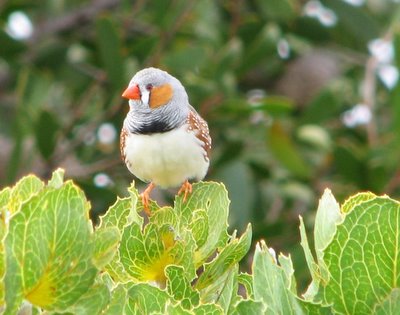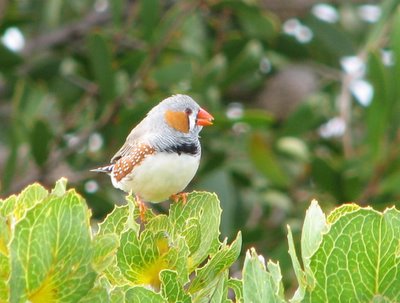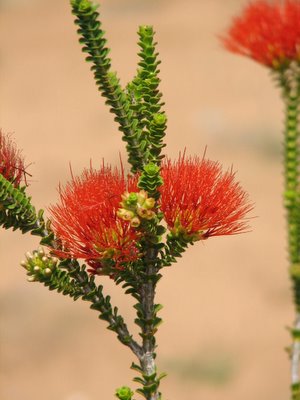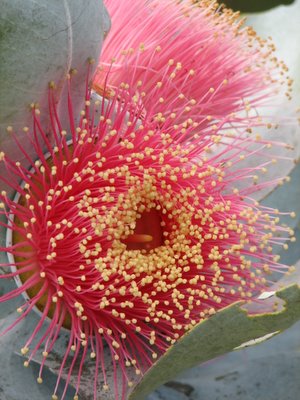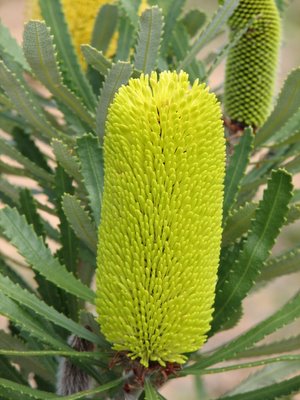Diamond Firetail Finches
Australian Finches would have to be on many people’s lists of beautiful birds. Some, like the Gouldian Finch of northern Australia, are simply stunning. It is no wonder that they are highly popular with aviculturalists.
Diamond Firetail
One of the local finches here in Murray Bridge South Australia is the very beautiful Diamond Firetail (Stagonopleura guttata). It is slightly smaller than the common House Sparrow found in many of our parks and gardens. The Diamond Firetail is widely spread in this district but is not common anywhere. According to the New Atlas of Australian Birds its distribution covers most of south eastern Australia south of a line from Port Augusta to Brisbane. It is not found in Tasmania. (To view map click here)
Description
The Diamond Firetail is a small bird some 12-13cm in size. It has a bright, unmistakable red beak and red rump with a black tail. Its throat and breast is white with a black band across it. The white spotted black flanks give it the appearance of diamonds studded along its sides.
Local occurrences
I have observed this beautiful species in a number of localities near my home. The best sightings have been in our own garden where it is in infrequent visitor. On several occasions it has delighted us in visiting our bird bath. Every time it has been such a brief visit. Its next visit must come soon – it hasn’t been since I bought my new camera. I’d love to get a close up photo of its stunning colours. [UPDATE: the photos on this page were added in March 2007]
An unusual sighting of this species was recorded recently near Callington (about 20km west of here). A large flock of over 35 was reported on Birdpedia. I have usually only seen them in ones or twos.
Gouldian Finch Recovery
Endangered Species
There was a beautiful item on ABC TV News in Adelaide this evening about Gouldian Finches, a highly endangered species of northern Australia. This stunning bird has been in decline both numerically and in distribution for some time. It is also one species I have yet to see in the wild. A friend used to keep some in an aviary; they are one of the world’s most beautiful birds.
Large flocks
The item on the news suggested that the Gouldian Finch is making a recovery. Evidently it has been seen in some localities for the first time in over 15 years. Colleen O’Malley, from the Threatened Species Network said that flocks of 200-400 are being seen which is vastly larger than in recent years. This is still far short of the sightings of flocks in the thousands in earlier days.
For the full story click here.
For more information, and photos which do not do the species justice click here.
A better photo can be found here.
I just hope the species not only survives – but thrives. I’d like it to be easy to find and photograph when I finally get to Kakadu, Arnhem Land or other parts of northern Australia.
Zebra Finch
Above: Photo of a Zebra Finch
We went to visit Pangarinda Arboretum again today. This is a large plantation of Australian native plants just east of Wellington, South Australia. This is about half an hour from Murray Bridge, or just over an hour from Adelaide.
As is my custom these days my attention was divided between watching birds, making a list of birds I see for my database, photographing any birds I see and photographing the many beautiful flowers in this arboretum. Summer is fast coming to an end here in the Murraylands region of South Australia so there are not too many native Australian plants in flower at present, but still enough for me to get some very nice shots.

The birding was also quite good with 23 species recorded. The best sighting of the day was that of Zebra Finches. I have recorded this species here before, but not in such good numbers. They almost outnumbered the commonest bird in the garden, the New Holland Honeyeater. A number of finches, including an obliging male, came close enough for me to get some lovely photos.
Pangarinda Arboretum, Wellington, South Australia

This morning we travelled down river through Tailem Bend to the small town of Wellington, South Australia. This town is near the end of the River Murray where it flows into Lake Alexandrina. From this lake it flows into the Coorong and out to the Southern Ocean.
Just east of the river at Wellington is the Pangarinda Arboretum. This consists of a plantation of Australian native plants established over a decade ago by local members of the Australian Plant Society (APS). The plantation has been planted in sections to represent different plant regimes from different parts of Australia.
Today’s gathering of members of APS was for a special Christmas lunch for members of the three local branches of APS. Members came from the Murray Bridge, Parrakie and Karoonda groups. Also present were members of the family of Ross Foreman who celebrates his 80th birthday tomorrow. Ross and his late wife Pat have been long time members of APS and they have freely given hundreds of volunteer hours of work to the arboretum. After cutting the birthday cake we all moved to another section of the plantation for Ross to open the Foreman Gazebo. This looks over the arboretum to the east and the river to the west.
After the ceremony we all wandered around the plantings looking at the many flowering plants. Some had finished their spring flowering but others, like the banksias, were resplendant in a variety of shapes and colours.
The bird watching was quite good too, with 22 species recorded, despite all the people wandering around. I managed to get some very good flower shots and one good photograph of a thornbill. The following is a list of the birds seen:
White Faced Heron
Pacific Black Duck
Nankeen Kestral
Swamp Harrier
Black Kite
White Ibis
Rock Dove
Peaceful Dove
Crested Pigeon
Galah
Elegant Parrot
Singing Honeyeater
New Holland Honeyeater
Magie Lark
Australian Magpie
Yellow Rumped Thornbill
Common Starling
House Sparrow
Common Blackbird
European Goldfinch
Willie Wagtail
One of the members who regularly does volunteer work there reported to me that Zebra Finches had been breeding in the plantation recently.


